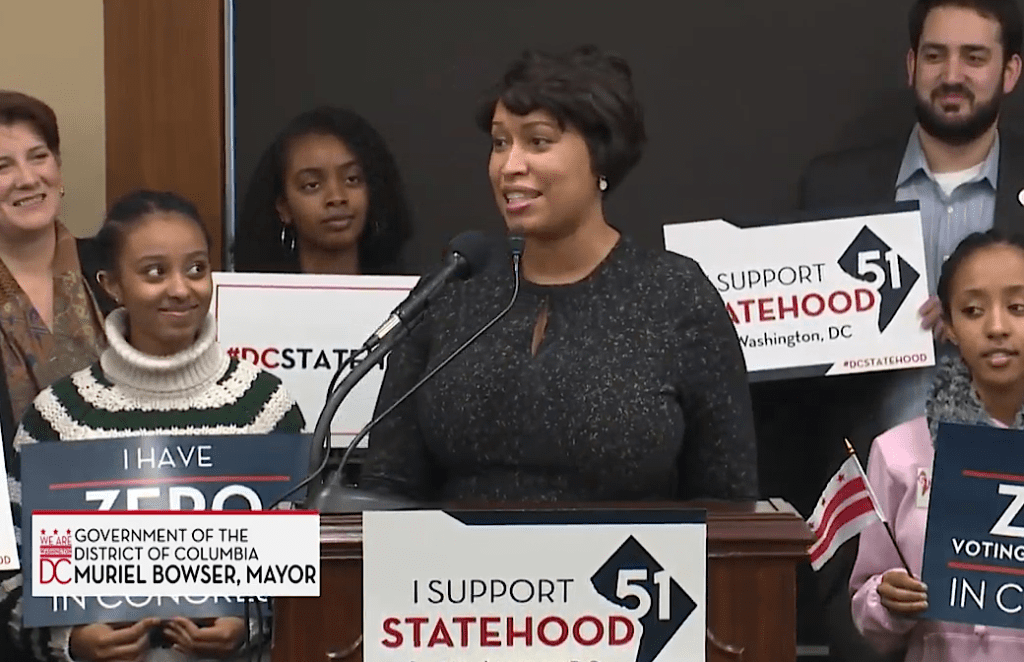It’s Historic: D.C. Statehood Moves Closer to Passage
By • March 11, 2019 0 1083

The decades-long effort to officially make most of the District of Columbia into the 51st state of the United States, took a giant step forward on Feb. 21 with the introduction in Congress of H.R. 51, the “Washington, D.C., Admission Act” by Delegate Eleanor Holmes Norton (D-D.C.)
The Georgetowner reported on Feb. 25 that the proposal had obtained a record 155 original cosponsors, “more than the number of Democrats who voted for the first-ever floor vote on statehood in 1993,” according to Norton. It now has 200 signees.
In the past three weeks, three significant steps towards statehood have occurred.
On Feb. 28 as part of the D.C. statehood lobby day, Mayor Muriel Bowser announced that Sen. Mark R. Warner (D-Va.) had agreed for the first time to support D.C. statehood. In a statement, Warner credited his reversal of opinion in part to Amazon’s decision last year to locate a large part of its new HQ2 in the Crystal City neighborhood of Arlington. The increase of jobs in Virginia decreased the risk Warner had feared would cause Washington as a state to impose a state commuter tax on Virginians who worked in D.C. Now with the possibility of a reverse commute – D.C. workers to Virginia – that concern was lessened, he said.
On March 8, the Democratic House passed H.R. 1, or the For the People Act, by a vote of 234-193. A broad Democratic priorities bill, H.R. 1 includes “extensive findings supporting statehood for D.C.” according to a statement from Norton. The bill also expands voting access and ethics investigations and requires presidential candidates to release tax documents among other things.
It’s the first time that either chamber of Congress has passed a measure endorsing D.C. statehood. “There is no other way to describe it — this is historic,” Norton said.
Senate Minority Leader Chuck Schumer followed up by declaring that he would make statehood for D.C. one of the top priorities for the Senate Democratic Caucus. That makes the first time that leaders of a chamber – the House or the Senate – has endorsed D.C. statehood.
Still, the prospects for passage of D.C. statehood remain remote.
Almost no Republican on Capitol Hill supports the statehood movement because the new state would vote almost entirely Democratic. Only four percent of those voted in D.C. in 2016 voted for Donald Trump, and fewer than five Republicans were on the D.C. ballot for any office. The U.S. Senate is dominated by Republicans until 2020 at least and will not pass a measure that certainly would give Democrats two more Senate seats.
Success in the House can mainly be attributed to the fact the 2018 midterm elections changed the majority of the House to the Democrats.
The argument resonates that the some 700,000 residents in the District are not given full representation in the House and Senate despite paying federal taxes — unlike the five U.S. territories that are not states but are represented in Congress, as is D.C., by elected delegates who can serve and vote on committees but not on the floor of the House.
The Constitution established that the seat of the U.S. Government be a district, not a state, not more than ten miles square. Most proposals for statehood leave the areas of federal buildings like Capitol Hill, the Mall with its neighboring federal agencies’ buildings and the White House as the District; the rest would be a single state.
But other proposals suggest that the population outside the federal buildings be retroceded to Maryland, where they originally belonged. D.C.’s original Virginia land retroceded in 1847.
Warner’s support of D.C. statehood now make House Majority Leader Steny H. Hoyer (D-Md.) the only Democratic federal lawmaker in the region who does not support statehood.

